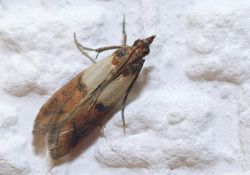Indian Meal Moth
 Description:
Description:
The Indian Meal Moth is a very troublesome and common pest that many families and businesses across the United States deal with on a daily basis. Pest found in flour mills, processing plants, dried fruit and on the surface of all types of grains. Indian meal moth larva's is a very common commercial and pantry pest. Like many other pests, the Indian Meal Moth is largely dependent upon its surrounding temperature and food availability for its survival. If there is an extreme change to either one of these factors, the Indian Meal’s life can be as short as one month. In ideal living conditions Indian Meal Moths can live upwards of one year. These moths are found on most continents, and have helped themselves to grains and food in manufacturing plants, grocery stores, restaurants and homes. Once an infestation has been found, humans have no choice but to throw away all contaminated food, as well as any food that could have been even mildly touched. Although Indian Meal Moths can be annoying and difficult to get rid of in a personal kitchen, they can be detrimental in a commercial setting. Restaurants and packaging plants can lose hundreds of dollars from damaged products they can also lose customer loyalty.
Appearance:
Adult has wingspread of about 14 – 20mm. Has pale gray wings, but the front wing is reddish brown and coppery on the outer two-thirds. Mature larva is usually dirty white, but may vary to greenish, pinkish, or brownish, depending on the food it eats. Head region is yellowish to reddish brown.
Lifecycle:
The Indian meal moth female lays approximately 200 eggs, on food material during a 1-18 day period of time. Temperature and availability of food determine the length of the larval stages. The last instar larva leaves the food to find a suitable place for pupation. The complete life cycle takes 25-135 days, with 4-6 generations per year.
Habits:
Their larvae produce the web material commonly found in food, such as dried fruits, whole wheat and, cornmeal, and shelled or ear corn. Attracted to grain, grain products; corn, lots of different dried foods, such as fruit, nuts, seeds, biscuits and powdered milk; chocolate, candy; dried red peppers; dry dog food etc.